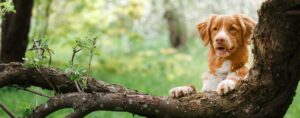
As dog owners, we strive to create a safe and enjoyable environment for our furry companions. While we may be well-versed in keeping them away from certain foods and toxic substances, it’s equally important to be aware of potential hazards present in our surroundings. In this comprehensive guide, we will explore the types of trees that dogs should avoid to ensure their well-being. By understanding the potential risks associated with certain tree species, we can take proactive measures to protect our beloved pets.
The Dangers of Certain Tree Species
Trees are an integral part of our natural surroundings, providing shade, beauty, and environmental benefits. However, not all trees are safe for dogs. Here are some common tree species that pose potential risks to our canine friends:
Sago Palm (Cycas revoluta): The Sago Palm, popular for its ornamental value, is highly toxic to dogs. All parts of this plant, including the seeds, leaves, and roots, contain cycasin—a toxic compound that can cause severe liver damage and even be fatal if ingested by dogs. It’s crucial to keep dogs away from Sago Palms, both indoors and outdoors.
Black Walnut (Juglans nigra): Black Walnut trees are known for their beautiful wood and tasty nuts. However, the tree produces a substance called juglone, which is toxic to dogs. An arborist book told me contact with the tree’s leaves, nuts, or hulls can cause gastrointestinal distress, including vomiting, diarrhea, and abdominal pain. Dogs should be discouraged from chewing or ingesting any part of the Black Walnut tree.
Cherry (Prunus spp.): Cherry trees, especially the wild black cherry (Prunus serotina), pose a potential risk to dogs. The bark, leaves, and pits of cherries contain cyanide compounds, which can be toxic if ingested in large quantities. While a small amount of cherry fruit is usually safe for dogs, it’s crucial to prevent them from accessing fallen fruit or chewing on branches, as it may lead to cyanide poisoning.
Trees with Irritating or Harmful Parts
In addition to toxic trees, there are certain species that may cause irritation or harm to dogs due to their physical characteristics:
Yew (Taxus spp.): Yew trees are widely used in landscaping due to their evergreen foliage and attractive appearance. However, all parts of the yew tree, including the needles and seeds, contain a toxic substance called taxine. Ingesting any part of the yew tree can lead to severe health complications, such as cardiac issues and respiratory distress.
Osage Orange (Maclura pomifera): The fruit of the Osage Orange tree, often referred to as “hedge apples,” can be a potential hazard for dogs. While the fruit itself is not highly toxic, it can cause gastrointestinal upset if ingested in large amounts. Additionally, the tree’s thorny branches can cause injury to dogs if they come into contact with them.
Preventive Measures and Safe Alternatives
Now that we have identified the trees that dogs should avoid, let’s explore some preventive measures and safe alternatives to ensure their well-being:
Awareness and Supervision: Familiarize yourself with the trees in your immediate surroundings and identify any potential risks. Keep a watchful eye on your dog during walks and outdoor playtime, preventing them from coming into contact with toxic or harmful tree species.
Training and Distraction Techniques: Teach your dog basic obedience commands, such as “leave it” or “drop it,” to discourage them from approaching or chewing on trees that may be hazardous. Offer appropriate chew toys or treats as distractions to redirect their attention from potentially harmful objects.
Create a Safe Outdoor Space: If you have a backyard or garden, consider creating a designated area where your dog can roam freely without access to toxic trees. Install barriers or fencing to prevent them from wandering into areas containing hazardous tree species.
Consult a Veterinarian: If you suspect your dog has ingested any part of a toxic tree or is displaying unusual symptoms, contact your veterinarian immediately. Prompt veterinary care is crucial in cases of potential poisoning or adverse reactions.
Conclusion
As responsible dog owners, it is our duty to keep our pets safe from potential hazards, including certain tree species. By being aware of the trees that dogs should avoid and implementing preventive measures, we can ensure their well-being and minimize the risks they may face in their surroundings. Remember, a healthy and happy dog starts with a safe environment.